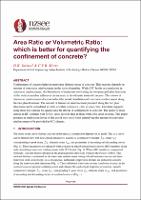| dc.contributor.author | Jaiswal, Devesh Kumar | |
| dc.contributor.author | Murty, C.V.R. | |
| dc.date.accessioned | 2023-08-28T04:23:35Z | |
| dc.date.available | 2023-08-28T04:23:35Z | |
| dc.date.issued | 2023-04-19 | |
| dc.identifier.uri | https://repo.nzsee.org.nz/xmlui/handle/nzsee/2615 | |
| dc.description.abstract | Confinement of concrete helps in improving ultimate strain of concrete. This increase depends on amount of transverse reinforcement in the vertical member. While the need for 1350 hooks in transverse reinforcement is mandatory, the distribution of transverse steel along the two principal plan directions of the vertical members affects this increase in the ultimate strain of concrete. Thus, the volume of transverse reinforcement alone does not reflect the actual distribution of transverse reinforcement along the two plan directions. The amount of transverse reinforcement along the two plan directions can be defined in terms of volumetric ratio or area ratio. Two competing models are available in literature for quantifying the effect of confinement of concrete, one using volumetric ratio and another using area ratio. The matter is more critical in columns with hollow cross-sections than in those with solid cross-sections. This paper will present a detailed analysis in favour of the use of area ratio when quantifying the amount of transverse reinforcing to be provided in columns. | |
| dc.language.iso | en | |
| dc.publisher | New Zealand Society for Earthquake Engineering | |
| dc.relation.ispartofseries | 2023;69 | |
| dc.subject | Advancements in structural and geotechnical assessment and design | |
| dc.title | Area Ratio or Volumetric Ratio: Which is better for quantifying the confinement of concrete? | |
| dc.type | Article | |

